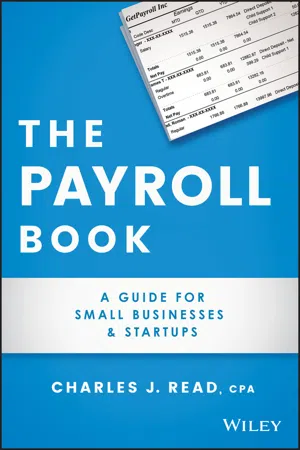
- English
- ePUB (mobile friendly)
- Available on iOS & Android
About this book
The Payroll Book is the only book that demystifies payroll with clear, concise, and real-world examples on how to tackle the process.
" The Payroll Book will be a valuable resource for the small business owner as well as for the entrepreneur planning a new venture. Thorough, well-organized, and thoughtfully written, this practical guide is an essential tool for managing the payroll process."
—Marilyn K. Wiley, Dean, College of Business, University of North Texas
"Failing to comply with the withholding, tax remittance, and report filing requirements in handling business payroll carries a high cost. Charles' book will guide entrepreneurs through the minefields of payroll processing and reporting in language that business owners can understand. Whether you already own or are planning to start your own business, The Payroll Book is an essential tool."
—James A. Smith, Past President and Chairman, Texas Society of CPAs
"If accounting is something you have not paid keen attention to in your startup, then this book can demystify the whole thing for you and then some! Logically set-up and highly practical in its approach! I highly recommend this book for any startup, entrepreneur, and, frankly, anyone thinking about starting a business. That said, if you already started a business it's just as important—this is a must-read!"
—Hubert Zajicek, CEO, Co-founder and Partner, Health Wildcatters
"Wow! This is the most comprehensive book of its kind. I have worked in payroll for over 25 years, and I would recommend this book as a reference to anyone who has a hand in payroll. From the novice just entering the field to the seasoned veteran, there is something in this book for everyone."
—Romeo Chicco, President, PayMaster
Frequently asked questions
- Essential is ideal for learners and professionals who enjoy exploring a wide range of subjects. Access the Essential Library with 800,000+ trusted titles and best-sellers across business, personal growth, and the humanities. Includes unlimited reading time and Standard Read Aloud voice.
- Complete: Perfect for advanced learners and researchers needing full, unrestricted access. Unlock 1.4M+ books across hundreds of subjects, including academic and specialized titles. The Complete Plan also includes advanced features like Premium Read Aloud and Research Assistant.
Please note we cannot support devices running on iOS 13 and Android 7 or earlier. Learn more about using the app.
Information
PART I
Payroll Setup
CHAPTER 1
Business Entity
CORPORATION




PARTNERSHIP
SOLE PROPRIETORSHIP
Table of contents
- Cover
- Table of Contents
- Preface
- PART I: Payroll Setup
- PART II: Running a Payroll
- PART III: Additional Essential Components
- Conclusion
- Appendix: Payroll Tax Calendar
- Glossary
- Index
- End User License Agreement